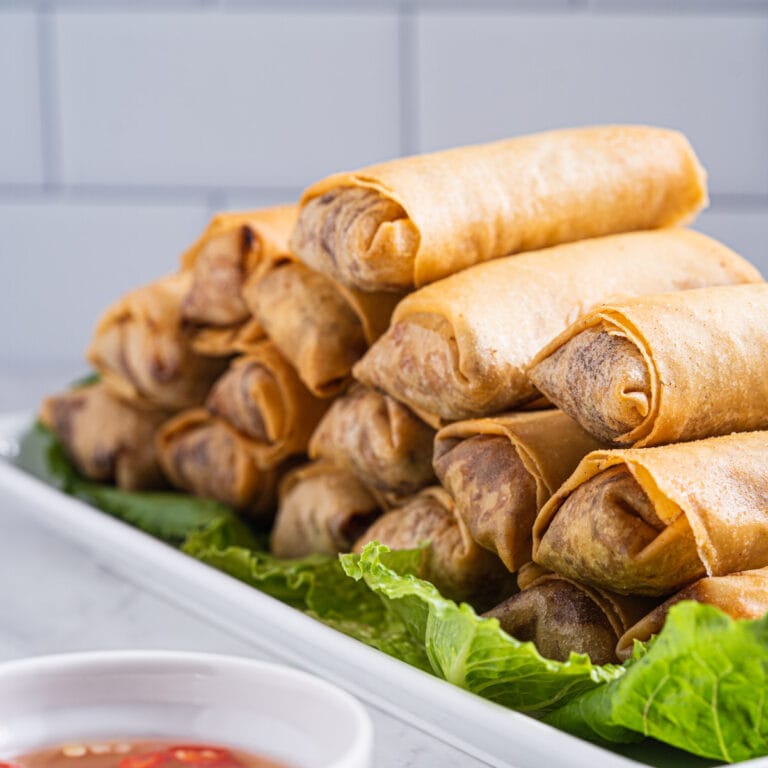Vietnamese Baguette (Banh Mi Bread)
If you’re a fan of Vietnamese cuisine or love a good sandwich, then learning how to make Vietnamese baguette, also known as Banh Mi bread, is a must! The combination of Vietnamese flavors and French bread results in a baguette that is crispy, fluffy, and delicious. Making Vietnamese baguettes at home may seem intimidating, but with a few simple ingredients and some basic kitchen tools, you can recreate this street food in your own kitchen.

The hallmark of a great banh mi bread is that it has a crispy, thin crust providing a satisfying crunch when bitten into. It should have a light, airy texture with a soft and fluffy crumb. It should have a slightly sweet flavor, which balances out the savory and tangy flavors of the fillings. It should be golden brown in color, indicating that it has been baked to perfection. It should have a distinct aroma with hints of yeast and a slightly sweet scent. Lastly, it should have a uniform shape with a slightly curved top and a tapered end.
Banh mi goes well with xui mai (meatballs) or thit nuong (grilled lemongrass pork). It is a popular street food in Vietnam. Be sure to check out my other Vietnamese street foods like Bột Chiên (Vietnamese Fried Rice Flour Cake), Pâté chaud | Bánh Patê Sô (Vietnamese Meat Pastries), or banh xeo (Vietnamese Savory Crepes).
Origins
The Vietnamese baguette, also known as banh mi baguette, originated in French colonialism in Vietnam in the late 19th century.
When the French arrived in Vietnam, they introduced French cuisine, including bread. However, the traditional French baguette was not suitable for the Vietnamese climate as it would become stale quickly due to the high humidity. To solve this problem, the Vietnamese adapted the recipe by making the bread smaller and lighter with a thinner crust, making it crispier and faster to bake.
The Vietnamese then filled the baguette with their own ingredients, including pickled vegetables, cilantro, and chili sauce, to create a unique fusion dish that combines French bread with Vietnamese flavors. Over time, various fillings have been added, such as grilled meats, pâté, and tofu, making banh mi a popular street food not only in Vietnam but also around the world.
What is the difference between Vietnamese and French baguettes?
There are several differences between Vietnamese baguettes and French baguettes, including:
- Size: Vietnamese baguette is usually shorter and slimmer than French baguette.
- Texture: A Vietnamese baguette has a thinner crust that is crispier than a French baguette. It is also typically lighter and airier due to the use of rice flour in the dough.
- Ingredients: Vietnamese baguette is typically filled with a variety of Vietnamese ingredients such as pickled carrots and daikon, cucumbers, cilantro, and various types of meat, while French baguette is often served plain or with butter, cheese, or charcuterie.
- Baking method: Vietnamese baguette is baked in a steam oven, which creates a softer texture and a thinner crust, while French baguette is usually baked in a regular oven with a hot, dry atmosphere, which creates a thicker and more robust crust.
Overall, while both baguettes share similarities in terms of their origin and basic ingredients, they differ significantly in texture, size, and the ingredients used for the filling.
Kitchen Equipment
- Digital Instant Read Thermometer: Use a digital instant read thermometer to measure the temperature of the water. The yeast will need to be in warm water at around 100-110°F.
- Baguette Pan: Use a nonstick baguette pan to make the bread the perfect shape without spreading.
- Digital Scale: Use a digital scale to measure the ingredients correctly and always get a consistent result.
- Kitchen Spray Bottle: Use a food-grade glass or plastic spray bottle. Fill it with water and spray it on the baguettes before and during baking. This creates a light, thin, and crunchy crust.
- Baker’s lame or sharp knife: Use a baker’s bread lame (a special curved blade) or sharp knife to make the 45° slashes on the baguette.
- Baking Pan: Use a baking pan or cookie sheet pan and fill it with water to put under the baguettes as they are baking to create steam.
Ingredients

- Instant Yeast: Instant yeast is very easy to use and very convenient as it’s sold in already portioned packets. This recipe uses 1 packet of instant yeast, but if you have a container of yeast, use 2 teaspoons or 7 grams. Make sure to activate it in warm sugar with water for a few minutes to get the best result.
- Sugar: Regular granulated sugar works best for this recipe. Sugar is essential to activate the yeast and guarantee perfect leavening.
- Salt: An essential ingredient in bread making. It contributes to the flavor and structure of the bread and tightens the gluten strands, making them stronger.
- Bread Flour: Bread flour is higher in protein than all-purpose flour, giving the dough an elastic consistency to facilitate the kneading. It will also give the bread more structure and texture.
- Butter: For this recipe, use unsalted butter. If you want to use salted butter, reduce the amount of additional salt.
- Egg: Use 1 large egg at room temperature to make this recipe.
Please scroll ⬇️ to the recipe card to see the full ingredient amounts and instructions.
How to Make Vietnamese Baguette (Banh Mi)
Make the starter
- Warm the water in the microwave for 30-35 seconds until it reaches 100℉-115℉. Add yeast and sugar to the water. Stir well and set it aside.

Make the dough
- Mix all the ingredients together and knead either by hand or with a stand mixer for 10-12 minutes.


- Transfer to a lightly oiled bowl and cover with plastic wrap. Let it rest in a warm place for an hour or until it doubles in size.


- Cut the dough into 6 equal triangle pieces (around 140g). Then, shape them into baguettes by pinching the two ends and rolling them down without touching the middle of the baguette. Place them on a baguette pan to retain the shape. Cut a 45° slit on each baguette with a sharp knife or a baker’s lame. Then, let it rest in a warm place, uncovered, for 45 minutes until it doubles in size.



Bake the bread
- Preheat the oven to 425℉. Fill a cookie sheet with enough water to cover the tray and place it on the bottom rack of the oven.
- Spray each baguette with water (about 4 spritzes around each baguette). Place the baguette pan in the oven on the top rack with the water tray directly below.
- Set the oven timer for 22 minutes. After 4 minutes, spray the baguettes with water, then close the oven and let them cook. Remove the water tray 10 minutes before the baking time ends.


Tips for Success
– Use a scale to measure the ingredients accurately. If you don’t have a scale, use the spoon and swipe method to measure the bread flour so that it’s not overpacked. Use a spoon to scoop the flour into the measuring cup. Then, use a knife or other straight-edged utensil to level the flour across the measuring cup.
– Use a thermometer to measure the temperature of the water. It should be around 100-115°F.
– Air temperature during the rise(s) should be between 75°F and 85°F.
– If you’re not sure if the dough has doubled in size, dust two fingers with flour and press them into the dough. If the indentation remains, it means the dough has risen enough and is ready for the next step. However, if the dough springs back, it requires more time to rise and should be left to continue proofing.

Troubleshooting
Problems with the dough
Q: Why is my dough really sticky?
A: Either there wasn’t enough flour, there wasn’t enough gluten in the dough or there was too much kneading.
Solution: Add more flour. Gradually add small amounts of flour to the dough, kneading well after each addition until the dough is no longer sticky. It’s important not to add too much flour, as this can make the dough dry and tough. Add just enough flour to get the desired consistency and texture.
Problems with the yeast
Q: Why didn’t my yeast bubble?
A: When you put the yeast in warm water, you should see bubbles after a few minutes. If not, there is one of three problems: the yeast is dead, the water is too hot, or the water is too cold.
Solution: Check the expiration date: Make sure that the yeast you are using has not expired. Old yeast may not work as well, if at all.
Check the temperature: Yeast requires a warm environment to activate and grow. If the temperature is too hot or too cold, the yeast may not work properly. The ideal temperature for activating yeast is between 100-110°F (37-43°C).
Proof the yeast: Mix the yeast with a small amount of warm water and sugar. Let it sit for about 5-10 minutes until it becomes frothy. This is called proofing the yeast. If it becomes frothy, it means the yeast is active and ready to use.
If none of these solutions work, it may be time to buy a new batch of yeast. Proper storage of yeast is important to ensure that it stays fresh and active. Store yeast in an airtight container in the refrigerator or freezer for best results.
Problems with the dough rise
Q: Why didn’t my bread rise, or why did it take so long to rise?
A: There could be several reasons; either the yeast wasn’t active, or the environment was too cold. It helps to place a towel, lid, or plastic wrap over the large bowl that your dough is in, so it contains the temperature.
Solution: Check the yeast: Make sure that the yeast you are using is fresh and active. If the yeast is expired or not active, it will not cause the dough to rise. Try proofing the yeast in warm water with a bit of sugar before adding it to the dough to make sure it is active.
Check the temperature: Yeast thrives in warm environments. If the dough is too cold, it may not rise properly. Make sure that the dough is kept in a warm place, such as in an oven with the light turned on or on top of a warm oven.
Check the moisture level: If the dough is too dry or too wet, it may not rise properly. Make sure that you are measuring the ingredients accurately and using the recommended amounts of flour and water. If the dough is too dry, add a bit more water. If it is too wet, add a bit more flour.
Give it more time: Sometimes, bread dough can take longer to rise than expected. If you have given it enough time and it still has not risen, let it sit for an additional 30 minutes to an hour.
Add more yeast: If the dough still has not risen, try adding a bit more yeast and letting it rise again.
Frequently Asked Questions (FAQ)
Yes, you can make the dough ahead of time and store it in the refrigerator for up to 24 hours. After the dough has risen and you have shaped it into baguettes, cover them with plastic wrap and place them in the refrigerator. When you’re ready to bake the baguettes, remove them from the refrigerator and let them come to room temperature for about 30 minutes before baking. This will help the baguettes rise properly in the oven and achieve a crispy crust.
Bread flour works best because it’s higher in protein than all-purpose flour, giving the dough an elastic consistency to facilitate the kneading. It will also give the bread more structure and texture. If you use all-purpose flour, the dough will be softer and the bread may not rise properly or turn out with a gummier consistency.
While it’s not necessary to use a dough improver to make Banh Mi, it can help improve the texture and overall quality of the bread. A dough improver is a combination of ingredients that helps strengthen the gluten in the dough, resulting in a better rise, a more uniform crumb, and a longer shelf life. However, traditional Banh Mi recipes typically do not call for the use of a dough improver, as the bread relies on the natural fermentation process to create its unique texture and flavor. Ultimately, it is up to personal preference whether to use a dough improver or not, and the quality of the bread can be achieved without it.

How to Store and Reheat Leftover Baguettes
How to Store
Store before baking: You can make the dough ahead of time and store it in the refrigerator for up to 24 hours. After the dough has risen and you have shaped it into baguettes, cover them with plastic wrap and place them in the refrigerator. When you’re ready to bake the baguettes, remove them from the refrigerator and let them come to room temperature for about 30 minutes before baking.
Store after baking: If instead, you want to store the baked baguettes, wrap them in plastic wrap or aluminum foil, making sure that it’s tightly sealed and there is no air inside. Store them at room temperature for 1 day or in the fridge for up to 3 days.
How to freeze
In case you have more bread than you can consume, storing baguettes in the freezer is an excellent option. Wrap the bread tightly in plastic wrap and place it in a resealable freezer bag or an airtight container. When ready to eat, allow the bread to thaw at room temperature for a few hours before reheating it briefly in the oven to restore its crusty texture.
It is important to note that while frozen baguettes can last up to three months, the quality and flavor may begin to decline after the first month. For this reason, it is best to consume frozen baguettes sooner rather than later.
How to Reheat
You can reheat the baguette in the oven at 350°F for about 10 minutes to restore its crustiness.
If you are looking for a fun and easy way to use leftover banh mi bread, make this Vietnamese Shrimp Toast.
RECIPE

Vietnamese Baguette (Banh Mi Baguette)
Ingredients
- 1 (7 g or ¼ oz) packet instant yeast (2 teaspoons)
- 260 milliliters warm water (100℉- 110℉)
- 8 grams granulated sugar (2 teaspoons)
- 500 grams bread flour
- 10 grams salt (2 teaspoons)
- 30 grams unsalted butter (melted) (2 tablespoons or ¼ stick)
- 1 large egg (room temperature)
Instructions
- Gather and prepare the ingredients: Take the egg out and leave it to reach room temperature. Weigh your flour; or measure it by gently spooning it into a cup, then sweeping off any excess.
- Make the starter: Place the water in a microwave safe bowl and heat it in the microwave for 30-35 seconds until it reaches 100℉-115℉. Add yeast and sugar to the water. Stir well and set it aside.
- Make the dough: Make and knead everything together – by hand or stand mixer. Kneading by stand mixer: Place on the dough hook. To the stand mixer bowl, add flour, salt, butter, and egg. Mix at a stand mixer speed of 1-2. Once the ingredients are incorporated, add the yeast and mix for 10 minutes at a speed of 3, until it is smooth and elastic.Kneading by hand: To a mixing bowl, add flour, salt, butter, and egg. Mix the ingredients together. Then, add the yeast. It will feel very wet and sticky. Knead by hand for 10-12 minutes, until it is smooth and elastic.
- Let the dough rise. Transfer to a lightly oiled bowl and cover with plastic wrap or a cloth. Allow the dough to rise in a warm place for 1 hour, or until it doubles in size.
- Roll into shape. Cut the dough into 6 equal triangle pieces (around 135g). Then, press the triangles down either with your hand or a rolling pin. Use your fingers to pinch the two ends and roll down as you're pinching. Do not touch press down in the middle. As you roll the dough, gradually taper the ends.
- Second Rise. Place it on a baguette pan. Put 2 in each slot, leaving an inch between. Use a baker's lame or sharp knife to cut a 45° slit on each baguette. Then, let it rest in a warm place for 45 minutes, uncovered, until it doubles in size.
- Preheat the oven to 425℉.
- Prepare the oven. Move the racks in the oven ⅓ way down and the second rack 2-3 slots down (about 4 inches below the first rack). Using a cookie sheet or tray that is as big as the baguette pan, fill it with enough water to cover the tray and place it on the bottom rack.
- Spray the baguettes with water. Using a food grade bottle spray, spray each baguette with water (about 4 spritzes around each baguette). Place the baguette pan in the oven on the top rack with the water tray directly below.
- Bake the baguettes. Set the oven timer for 22 minutes. Spray the baguettes with water 4 minutes into the cooking time. Then, close the oven and let it cook. 10 minutes before the baking time ends, remove the water tray and let it continue baking.
Notes
- Use a scale to accurately measure the ingredients. If you are not using a scale, do not pack the bread flour. Use a spoon to scoop the flour into the measuring cup. Then, use a knife or other straight-edged utensil to level the flour across the measuring cup.
- Use a thermometer to measure the temperature of the water. It should be around 100-110°F.
- Air temperature during the rise(s) should be between 75°F and 85°F.
- If you’re not sure if the dough has doubled in size, dust two fingers with flour and press them into the dough. If the indentation remains, it means the dough has risen enough and is ready for the next step. However, if the dough springs back, it requires more time to rise and should be left to continue proofing.







It says at the top the difference between a French baguette and a bahn mi is the incorporation of rice flour… And yet your recipe calls for bread flour. Can you explain this change and what this version is or when and how much rice flour to add.
Hi Raquel,
Great question! I have tested it with rice flour and ended up with a dense baguette. It might work in tropical climates like Vietnam, but it didn’t work for me.
According to America’s Test Kitchen, “there are a few ways Vietnamese bakeries can achieve this quintessential crispness. Some recipes call for rice flour along with a higher-protein bread flour, a blend which can contribute to the light and airy texture. But that’s not a requirement, Nguyen says. The proprietary banh mi recipe she commissions for Soall from a local baker uses all-purpose flour.” https://www.americastestkitchen.com/articles/3504-what-makes-banh-mi-baguettes-so-light-and-crispy
The main difference between French bread and Vietnamese bread that banh mi has a thinner crust from steaming water beneath the loaf while baking.
Instead of making 6 individual baguettes, I split the dough in half and made two. Recipe was easy to follow and so far, this recipe is the best one I’ve tried for baguettes for my banh-mi’s. Thank you!
Thank you for sharing your experience! So glad it worked out!
Hey there! I just came across your post on Vietnamese baguettes, and I have to say, it’s fantastic! Your description of the crispy yet fluffy baguette filled with flavorful meats and fresh veggies transported me right to the streets of Vietnam. I appreciate how you highlighted the perfect balance of textures and the vibrant taste combinations. Your attention to detail really shines through, and it’s evident that you have a deep appreciation for this culinary gem. Keep up the great work, and I can’t wait to read more of your delicious adventures!
Can’t beat homemade baguettes and now I have the Vietnamese version. So fluffy and delicious.
I love a good sandwich and you can’t beat a great tasting baguette.
I love that this was a complete guide for everyone who wants a Bahn Mi Bread! Thanks for sharing!!
came out excellent and so tasty. I am so happy that we can now enjoy homemade baguette and don’t have to get it from the store anymore.